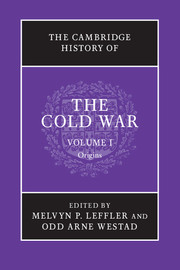Book contents
- Frontmatter
- 1 The Cold War and the international history of the twentieth century
- 2 Ideology and the origins of the Cold War, 1917–1962
- 3 The world economy and the Cold War in the middle of the twentieth century
- 4 The emergence of an American grand strategy, 1945–1952
- 5 The Soviet Union and the world, 1944–1953
- 6 Britain and the Cold War, 1945–1955
- 7 The division of Germany, 1945–1949
- 8 The Marshall Plan and the creation of the West
- 9 The Sovietization of Eastern Europe, 1944–1953
- 10 The Cold War in the Balkans, 1945–1956
- 11 The birth of the People’s Republic of China and the road to the Korean War
- 12 Japan, the United States, and the Cold War, 1945–1960
- 13 The Korean War
- 14 US national security policy from Eisenhower to Kennedy
- 15 Soviet foreign policy, 1953–1962
- 16 East Central Europe, 1953–1956
- 17 The Sino-Soviet alliance and the Cold War in Asia, 1954–1962
- 18 Nuclear weapons and the escalation of the Cold War, 1945–1962
- 19 Culture and the Cold War in Europe
- 20 Cold War mobilization and domestic politics: the United States
- 21 Cold War mobilisation and domestic politics: the Soviet Union
- 22 Decolonization, the global South, and the Cold War, 1919–1962
- 23 Oil, resources, and the Cold War, 1945–1962
- Bibliographical essay
- Index
- References
18 - Nuclear weapons and the escalation of the Cold War, 1945–1962
Published online by Cambridge University Press: 28 September 2010
- Frontmatter
- 1 The Cold War and the international history of the twentieth century
- 2 Ideology and the origins of the Cold War, 1917–1962
- 3 The world economy and the Cold War in the middle of the twentieth century
- 4 The emergence of an American grand strategy, 1945–1952
- 5 The Soviet Union and the world, 1944–1953
- 6 Britain and the Cold War, 1945–1955
- 7 The division of Germany, 1945–1949
- 8 The Marshall Plan and the creation of the West
- 9 The Sovietization of Eastern Europe, 1944–1953
- 10 The Cold War in the Balkans, 1945–1956
- 11 The birth of the People’s Republic of China and the road to the Korean War
- 12 Japan, the United States, and the Cold War, 1945–1960
- 13 The Korean War
- 14 US national security policy from Eisenhower to Kennedy
- 15 Soviet foreign policy, 1953–1962
- 16 East Central Europe, 1953–1956
- 17 The Sino-Soviet alliance and the Cold War in Asia, 1954–1962
- 18 Nuclear weapons and the escalation of the Cold War, 1945–1962
- 19 Culture and the Cold War in Europe
- 20 Cold War mobilization and domestic politics: the United States
- 21 Cold War mobilisation and domestic politics: the Soviet Union
- 22 Decolonization, the global South, and the Cold War, 1919–1962
- 23 Oil, resources, and the Cold War, 1945–1962
- Bibliographical essay
- Index
- References
Summary
Nuclear weapons are so central to the history of the Cold War that it can be dificult to disentangle the two. Did nuclear weapons cause the Cold War? Did they contribute to its escalation? Did they help to keep the Cold War “cold”? We should also ask how the Cold War shaped the development of atomic energy. Was the nuclear-arms race a product of Cold War tension rather than its cause?
The atomic bomb and the origins of the Cold War
The nuclear age began before the Cold War. During World War II, three countries decided to build the atomic bomb: Britain, the United States, and the Soviet Union. Britain put its own work aside and joined the Manhattan Project as a junior partner in 1943. The Soviet effort was small before August 1945. The British and American projects were driven by the fear of a German atomic bomb, but Germany decided in 1942 not to make a serious effort to build the bomb. In an extraordinary display of scientific and industrial might, the United States made two bombs ready for use by August 1945. Germany was defeated by then, but President Harry S. Truman decided to use the bomb against Japan.
The decision to use the atomic bomb has been a matter of intense controversy. Did Truman decide to bomb Hiroshima and Nagasaki in order, as he claimed, to end the war with Japan without further loss of American lives? Or did he drop the bombs in order to intimidate the Soviet Union, without really needing them to bring the war to an end? His primary purpose was surely to force Japan to surrender, but he also believed that the bomb would help him in his dealings with Iosif V. Stalin. That latter consideration was secondary, but it confirmed his decision. Whatever Truman’s motives, Stalin regarded the use of the bomb as an anti-Soviet move, designed to deprive the Soviet Union of strategic gains in the Far East and more generally to give the United States the upper hand in defining the postwar settlement. On August 20, 1945, two weeks to the day after Hiroshima, Stalin signed a decree setting up a Special Committee on the Atomic Bomb, under the chairmanship of Lavrentii P. Beriia. The Soviet project was now a crash program.
- Type
- Chapter
- Information
- The Cambridge History of the Cold War , pp. 376 - 397Publisher: Cambridge University PressPrint publication year: 2010
References
- 16
- Cited by



